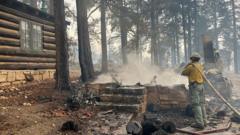The Trump administration's recent cuts to staffing in national parks and forests have led to significant backlash as visitors experience longer wait times, closed trails, and concerns over conservation efforts. The drastic reduction in workforce has jeopardized ecosystem management and public safety, prompting fears of a diminished experience for outdoor enthusiasts.
National Parks Face Turmoil as Staffing Cuts Spark Outcry

National Parks Face Turmoil as Staffing Cuts Spark Outcry
Widespread job reductions within U.S. national parks and forests are raising alarms among conservationists and the public regarding safety and the preservation of natural resources.
The cuts to the workforce in U.S. national parks and forests, driven by the Trump administration, have become a flashpoint for dissatisfaction among environmental advocates and park visitors alike. With nearly 5% of the National Park Service and about 10% of the U.S. Forest Service staff let go, the impacts are being keenly felt across the country. Public facilities are experiencing more traffic and less attention, leading to overflowing toilets, longer lines at park entrances, and visitor centers operating under reduced hours.
In the stunning wilderness of the Enchantments in Washington state, ranger Kate White highlights the concerns as her team, typically hauling out hundreds of pounds of litter, faces job loss and potential environmental degradation without adequate staff to maintain backcountry service. “Our primary job was keeping people safe,” White emphasizes, pointing to the critical role they played amid the high risks of the challenging terrain.
The mass employee terminations announced on February 14 have compounded operational struggles for parks, where visitor numbers soar every season. The losses are particularly harsh at high-traffic areas like the Grand Canyon, where entry delays have caused long queues of cars. Park service closures are becoming increasingly common, with trails being shut down indefinitely due to staffing shortages.
Protest against the cuts has emerged in various forms, including a demonstration at Yosemite National Park, where a group displayed an upside-down American flag. Former National Park employee Andria Townsend, who lost her job in the cuts, fears for endangered species like the Sierra Nevada red fox, noting her teams’ previous efforts to protect their diminishing populations.
Other impacted workers, like Claire Thompson and Xander Demetrios, echo sentiments of disappointment and devaluation of their efforts amidst harsh working conditions. They argue that their long hours and hazardous work for meager pay were ignored in judgments leading to massive layoffs.
In response to public pressure, some national park staff have reportedly been rehired after the cuts. Interior Secretary Doug Burgum has stated his commitment to hiring over 5,000 seasonal workers during the upcoming busy months. Yet, while the cuts were initially justified as a fiscal necessity linked to a $2 trillion deficit, advocates stress that the integrity of these natural resources and the safety of outdoor enthusiasts must not be compromised.
Outdoor enthusiasts are advised to prepare for significant changes in services, including litter management and lodging availability. Without a reversal of current policies, the National Parks Conservation Association warns that visitors should anticipate diminished experiences. Concerns remain about the unavailability of personnel needed for urgent environmental issues, such as wildfire management during the dry season.
As communities rally and protests become more prominent, the future of the national parks remains uncertain in the wake of these significant staffing reductions, emphasizing the need for a balanced approach between budget constraints and environmental stewardship.





















